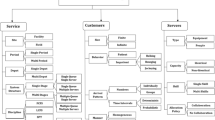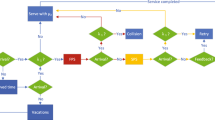Abstract
In this paper, we study a tandem queue with retrials where the queue experiences disasters. The probability of system failure depends on the strength of equipment, which makes servers idle and causes the removal of all customers in queues and service areas at once. The customers in the queue are forced to orbit in a retrial queue during the system failure where they decide whether or not to come back to the system. Reducing the disaster arrival rate (the probability of system failure) by employing more servers and reducing the number of lost customers is very costly. Moreover, it is important to service the customers with no interruption and reduce the time in system. The developed scenarios are compared in five dimensions including time in system, cost of lost customer, operator cost, the number of uninterrupted service customers and cost of reducing disaster arrival rate (or empowering system cost). The scenarios are modeled by computer simulation. Then, the optimal scenario is chosen using data envelopment analysis. The optimal scenario maximizes system efficiency in terms of disaster arrival rate, cost of lost customers and the number of satisfied customers. In the main problem, the disasters arrive at the system according to Poisson process; the effect of changing the distribution function of disaster arrival has been investigated finally. We are among the first ones to study and optimize G/G/K tandem queuing systems with system failures and retrial phenomena in interactive voice response systems.



Similar content being viewed by others
References
Canonaco, P., et al. (2008). A queuing network model for the management of berth crane operations. Computers & Operations Research, 35(8), 2432–2446.
Azadeh, A., Mohammad Ebrahim, R., & Eivazy, H. (2010). Parameter optimization of tandem queue systems with finite intermediate buffers via fuzzy simulation. Performance Evaluation, 67(5), 353–360.
Sergeev, A., & Goncharov, A. (2013). Simulating the operation of production systems. Russian Engineering Research, 33(1), 32–35.
Gaafar, L. K., & Shaik, J. (1997). A simulation-based shop floor monitoring and decision support system. Intelligent Automation & Soft Computing, 3(3), 261–272.
Bandyopadhyay, S. (2001). Traffic flow analysis through computer simulation models. Journal of the Institution of Engineers, India, Civil Engineering Division, 82(AOU), 119–124.
Jamal, A., Syahputra, R., & Suripto, S. (2016). Performance evaluation of wind turbine with doubly-fed induction generator. International Journal of Applied Engineering Research, 11(7), 4999–5004.
Liao, D.-Y., Lee, C.-J., & Lee, Y.-H. (2004). A multi-class, tandem queue model for priority quota assignment in semiconductor manufacturing. In Proceedings of the 5th Asia-Pacific industrial engineering and management systems conference (APIEM2004).
Paul, G. (2007). A complexity O (1) priority queue for event driven molecular dynamics simulations. Journal of Computational Physics, 221(2), 615–625.
Orozco, J., et al. (2005). A simulation study of the Adaptive RIO (A-RIO) queue management algorithm. Computer communications, 28(3), 300–312.
Chatten, A., Tuladhar, S., & Nelson, J. (2005). Modelling hole transport in conjugated polymers and blends for solar cell applications. In Photovoltaic specialists conference, 2005. Conference record of the thirty-first IEEE. IEEE.
Erbas, C., et al. (2007). A framework for system-level modeling and simulation of embedded systems architectures. EURASIP Journal on Embedded Systems, 2007, 082123. https://doi.org/10.1155/2007/82123.
Xu, Q., & Ma, Z. (2008). Discrete time Geo/G/1 queue with Bernoulli gated service simulation system. Applied Mathematics and Computation, 204(1), 37–44.
Alnowibet, K. A., & Perros, H. (2009). Nonstationary analysis of the loss queue and of queueing networks of loss queues. European Journal of Operational Research, 196(3), 1015–1030.
Haughton, M., & Sapna Isotupa, K. (2012). Scheduling commercial vehicle queues at a Canada–US border crossing. Transportation Research Part E: Logistics and Transportation Review, 48(1), 190–201.
Dahl, T. A., & Willemain, T. R. (2001). The effect of long-memory arrivals on queue performance. Operations Research Letters, 29(3), 123–127.
Manitz, M. (2008). Queueing-model based analysis of assembly lines with finite buffers and general service times. Computers & Operations Research, 35(8), 2520–2536.
Cruz, F. R., MacGregor Smith, J., & Medeiros, R. (2005). An M/G/c/c state dependent queuing network simulation model. Computers & Operations Research, 32(4), 919–941.
Furmans, K., Huber, C., & Wisser, J. (2009). Queueing Models for manual order picking systems with blocking. Logistics Journal, 1(01), 1–16.
Cruz, F. R., Oliveira, P., & Duczmal, L. (2010). State-dependent stochastic mobility model in mobile communication networks. Simulation Modelling Practice and Theory, 18(3), 348–365.
Klimenok, V., & Dudina, O. (2017). Retrial tandem queue with controllable strategy of repeated attempts. Quality Technology & Quantitative Management, 14(1), 74–93.
Esmer, S., Yildiz, G., & Tuna, O. (2013). A new simulation modelling approach to continuous berth allocation. International Journal of Logistics Research and Applications, (ahead-of-print), pp. 1–12.
Koba, E. V. (2004). Service retrial queues ergodicity investigation by the statistical simulation method. Journal of Automation and Information Sciences, 36(12), 36–43.
Ponomarenko, L. A., ogly Melikov, A. Z., & Ogly Babaev, A. T. (2005). A numerical method to study mobile cellular networks models with finite queue of \(< {i}> {h}</{i}>-calls\). Journal of Automation and Information Sciences, 37(6), 1–11.
Tovia, F. (2007). An emergency logistics response system for natural disasters. International Journal of Logistics Research and Applications, 10(3), 173–186.
Artalejo, J. R., & Lopez-Herrero, M. (2007). A simulation study of a discrete-time multiserver retrial queue with finite population. Journal of Statistical Planning and Inference, 137(8), 2536–2542.
Wang, J., Huang, Y., & Dai, Z. (2011). A discrete-time on-off source queueing system with negative customers. Computers & Industrial Engineering, 61(4), 1226–1232.
Artalejo, J. R. (2010). Accessible bibliography on retrial queues: Progress in 2000–2009. Mathematical and Computer Modelling, 51(9), 1071–1081.
Wang, J., Liu, B., & Li, J. (2008). Transient analysis of an M/G/1 retrial queue subject to disasters and server failures. European Journal of Operational Research, 189(3), 1118–1132.
Artalejo, J. R., Economou, A., & Gómez-Corral, A. (2008). Algorithmic analysis of the Geo/Geo/c retrial queue. European Journal of Operational Research, 189(3), 1042–1056.
Do, T. V. (2010). A new computational algorithm for retrial queues to cellular mobile systems with guard channels. Computers & Industrial Engineering, 59(4), 865–872.
Jolai, F., Asadzadeh, S., & Taghizadeh, M. (2008). Performance estimation of an email contact center by a finite source discrete time Geo/Geo/1 queue with disasters. Computers & Industrial Engineering, 55(3), 543–556.
Azadeh, A., et al. (2011). An integrated artificial neural network-computer simulation for optimization of complex tandem queue systems. Mathematics and Computers in Simulation, 82(4), 666–678.
Azadeh, A., Ghaderi, S., & Izadbakhsh, H. (2008). Integration of DEA and AHP with computer simulation for railway system improvement and optimization. Applied Mathematics and Computation, 195(2), 775–785.
Azadeh, A., et al. (2012). An integrated fuzzy regression-data envelopment analysis algorithm for optimum oil consumption estimation with ambiguous data. Applied Soft Computing, 12(8), 2614–2630.
Azadeh, A., & Alem, S. M. (2010). A flexible deterministic, stochastic and fuzzy data envelopment analysis approach for supply chain risk and vendor selection problem: Simulation analysis. Expert Systems with Applications, 37(12), 7438–7448.
Azadeh, A., Ghaderi, S., & Nasrollahi, M. (2011). Location optimization of wind plants in Iran by an integrated hierarchical data envelopment analysis. Renewable Energy, 36(5), 1621–1631.
Khare, V., Nema, S., & Baredar, P. (2017). Optimisation of the hybrid renewable energy system by HOMER, PSO and CPSO for the study area. International Journal of Sustainable Energy, 36(4), 326–343.
Nelson, R. D., & Philips, T. K. (1993). An approximation for the mean response time for shortest queue routing with general interarrival and service times. Performance evaluation, 17(2), 123–139.
Brandt, A., et al. (1997). Modelling and optimization of call distribution systems. Teletraffic Science and Engineering, 2, 133–144.
Srinivasan, R., Talim, J., & Wang, J. (2004). Performance analysis of a call center with interactive voice response units. Top, 12(1), 91–110.
Khudyakov, P., Feigin, P. D., & Mandelbaum, A. (2010). Designing a call center with an IVR (interactive voice response). Queueing Systems, 66(3), 215–237.
de Castro, J. M., et al. (2016). System and method for telephony and communication services with message-based API. Google Patents.
Casasola, J., & Ragsdale, J. (2017). Adjustable interactive voice response system. US Patent 20,170,085,714.
Roux, B. J., & Webster, C. A. (2017). Applying user preferences, behavioral patterns and environmental factors to an automated customer support application. Google Patents.
Colladon, A. F., Naldi, M., & Schiraldi, M. M. (2013). Quality management in the design of TLC call centres. International Journal of Engineering Business Management, 5, 48.
Stolletz, R. (2012). Performance analysis and optimization of inbound call centers. New York: Springer.
Little, J. D. C. (1961). A proof for the queuing formula: \(L = \lambda W\). Operations Research, 9(3), 383–387.
Azaron, A., & Modarres, M. (2005). Distribution function of the shortest path in networks of queues. OR Spectrum, 27(1), 123–144.
Levitin, G., & Amari, S. (2008). Multi-state systems with multi-fault coverage. Reliability Engineering & System Safety, 93(11), 1730–1739.
Charnes, A., et al. (2013). Data envelopment analysis: Theory, methodology, and applications. New York: Springer.
Charnes, A., Cooper, W. W., & Rhodes, E. (1978). Measuring the efficiency of decision making units. European Journal of Operational Research, 2(6), 429–444.
Cooper, W. W., Seiford, L. M., & Zhu, J. (2011) Data envelopment analysis: History, models, and interpretations. In Handbook on data envelopment analysis, pp. 1–39. New York: Springer.
Banker, R. D., Charnes, A., & Cooper, W. W. (1984). Some models for estimating technical and scale inefficiencies in data envelopment analysis. Management Science, 30(9), 1078–1092.
Fancello, G., Uccheddu, B., & Fadda, P. (2014). Data envelopment analysis (DEA) for urban road system performance assessment. Procedia-Social and Behavioral Sciences, 111, 780–789.
Beccalli, E., Casu, B., & Girardone, C. (2006). Efficiency and stock performance in European banking. Journal of Business Finance & Accounting, 33(1–2), 245–262.
Titko, J., & Jureviciene, D. (2014). DEA application at cross-country benchmarking: Latvian vs. Lithuanian banking sector. Procedia-Social and Behavioral Sciences, 110, 1124–1135.
Jain, S., & Smith, J. M. (1994). Open finite queueing networks with \(< {i}> {M}/{M}/{C}/{K}</{i}>\) parallel servers. Computers & operations research, 21(3), 297–317.
Mandelbaum, A., et al. (2002). Queue lengths and waiting times for multiserver queues with abandonment and retrials. Telecommunication Systems, 21(2–4), 149–171.
Greasley, A. (2004). Using DEA and simulation in guiding operating units to improved performance. Journal of the Operational Research Society, 56(6), 727–731.
Kim, C. S., et al. (2007). The tandem queue with feedback and losses. Performance Evaluation, 64(7), 802–818.
Filippoupolitis, A., et al. (2008). Emergency response simulation using wireless sensor networks. In Proceedings of the 1st international conference on Ambient media and systems. ICST (Institute for Computer Sciences, Social-Informatics and Telecommunications Engineering).
Lee, Y. M., Ghosh, S., & Ettl, M. (2009). Simulating distribution of emergency relief supplies for disaster response operations. In Winter Simulation Conference.
Su, Y., Huang, X., & Jin, Z. (2009). Modeling emergency service centers with simulation and system dynamics. In Computer Modelling and Simulation. UKSIM’09. 11th International Conference on IEEE. IEEE.
Azadeh, A., et al. (2011). An integrated fuzzy simulation-fuzzy data envelopment analysis algorithm for job-shop layout optimization: The case of injection process with ambiguous data. European Journal of Operational Research, 214(3), 768–779.
Acknowledgements
Funding was provided by University of Tehran (Grant No. 8106013/1/21).
Author information
Authors and Affiliations
Corresponding author
Additional information
A. Azadeh: Deceased.
Appendix: Visual SLAM network
Appendix: Visual SLAM network

Rights and permissions
About this article
Cite this article
Azadeh, A., Naghavi lhoseiny, M.S. & Salehi, V. Optimum alternatives of tandem G/G/K queues with disaster customers and retrial phenomenon: interactive voice response systems. Telecommun Syst 68, 535–562 (2018). https://doi.org/10.1007/s11235-017-0397-x
Published:
Issue Date:
DOI: https://doi.org/10.1007/s11235-017-0397-x




